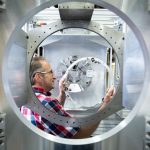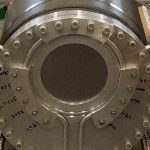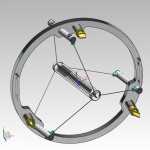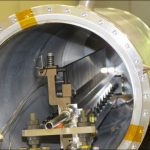From Interactions.org, Nov. 9, 2020: Large-scale accelerator facilities around the world, such as Fermilab and the Japan Proton Accelerator Research Complex, send near-light-speed proton beams into pieces of material called a target. The collision produces other particles, which scientists study to learn the fundamental constituents of matter. The RaDIATE collaboration has published new results on a target material made of a titanium alloy, shedding light on how different titanium materials respond to collisions by powerful proton beams.
targetry
From University of Wisconsin-Madison, Sept. 28, 2020: Getting blasted with proton beams takes a toll on accelerator targets. As researchers begin to consider upgrading existing accelerators and building more powerful models, the durability of those devices is a major concern. University scientists are working with Fermilab in a new collaboration to study and improve the durability of targets and target windows, which will be important for neutrino experiments such as the international Deep Underground Neutrino Experiment, hosted by Fermilab.
Fermilab is currently upgrading its accelerator complex to produce the world’s most powerful beam of high-energy neutrinos. To generate these particles, the accelerators will send an intense beam of protons traveling near the speed of light through a maze of particle accelerator components before passing through metallic “windows” and colliding with a stationary target. Researchers are testing the endurance of windows made of a titanium alloy, exposing samples to high-intensity proton beams to see how well the material will perform.
Fermilab scientists are preparing for future, high-power particle beams with a technological advance inspired by spinning sugar. It’s a new type of target — the material that beams collide with to produce other particles, such as neutrinos. The target is designed to be able to withstand the heat from high-intensity beams, expanding the potential of experiments that use them. Researching this new patent-pending technology already has led to a TechConnect Innovation Award and might have applications in the medical field.





